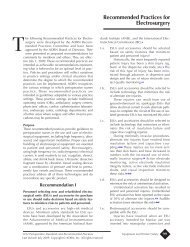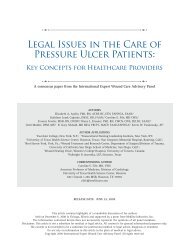Q2B.2. Hydrophilic catheters vs. st<strong>and</strong>ard cathetersVery low-quality evidence suggested a benefit of hydrophilic catheters over st<strong>and</strong>ard nonhydrophiliccatheters in specific populations undergoing clean intermittent catheterization. 137,144-148,169 This was based on a decreased risk of SUTI, bacteriuria, hematuria, <strong>and</strong> pain duringinsertion, <strong>and</strong> increased patient satisfaction. Differences in <strong>CAUTI</strong> outcomes were limited to onestudy of spinal cord injury patients <strong>and</strong> one study of patients receiving intravesicalimmunochemoprophylaxis <strong>for</strong> bladder cancer, while multiple other studies found no significantdifferences.Q2B.3. Closed vs. open drainage systemsVery low-quality evidence suggested a benefit of using a closed rather than open urinarydrainage system. 89,171 This was based on a decreased risk of bacteriuria with a closed drainagesystem. One study also found a suggestion of a decreased risk of SUTI, bacteremia, <strong>and</strong> UTIrelatedmortality associated with closed drainage systems, but differences were not statisticallysignificant. Sterile, continuously closed drainage systems became the st<strong>and</strong>ard of care basedon an uncontrolled study published in 1966 demonstrating a dramatic reduction in the risk ofinfection in short-term catheterized patients with the use of a closed system. 23 Recent data alsoinclude the finding that disconnection of the drainage system is a risk factor <strong>for</strong> bacteriuria(Q1B).Q2B.4. Complex vs. simple drainage systemsLow-quality evidence suggested no benefit of complex closed urinary drainage systems oversimple closed urinary drainage systems. 150-152,154,172,176,177 Although there was a decreased riskof bacteriuria with the complex systems, differences were found only in studies published be<strong>for</strong>e1990, <strong>and</strong> not in more recent studies. The complex drainage systems studied included variousmechanisms <strong>for</strong> reducing bacterial entry, such as antiseptic-releasing cartridges at the drainport of the urine collection bag; see evidence table <strong>for</strong> systems evaluated.Q2B.5. Preconnected/sealed junction catheters vs. st<strong>and</strong>ard cathetersLow-quality evidence suggested a benefit of using preconnected catheters with junction sealsover catheters with unsealed junctions to reduce the risk of disconnections. 64,153,156,175 This wasbased on a decreased risk of SUTI <strong>and</strong> bacteriuria with preconnected sealed catheters. Studiesthat found differences had higher rates of <strong>CAUTI</strong> in the control group than studies that did notfind an effect.Q2B.6. Catheter valves vs. drainage bagsModerate-quality evidence suggested a benefit of catheter valves over drainage bags inselected patients with indwelling urinary catheters. 140 Catheter valves led to greater patientsatisfaction but no differences in bacteriuria/unspecified UTI or pain/bladder spasms. Detailsregarding the setting <strong>for</strong> recruitment <strong>and</strong> follow-up of the patients in the studies were unclear,<strong>and</strong> the majority of subjects were men. Our search did not reveal data on the effect of cathetervalves on bladder function, bladder/urethral trauma, or catheter blockage.40
Evidence Review Table 2B. What are the risks <strong>and</strong> benefits associated with differentcatheters or collecting systems?2B.1. If the <strong>CAUTI</strong> rate is not decreasing after implementing a comprehensive strategy toreduce rates of <strong>CAUTI</strong>, consider using antimicrobial/antiseptic-impregnated catheters. Thecomprehensive strategy should include, at a minimum, the high priority recommendations <strong>for</strong>urinary catheter use, aseptic insertion, <strong>and</strong> maintenance (see Section III. Implementation <strong>and</strong>Audit). (Category IB)2B.1.a. Further research is needed on the effect of antimicrobial/antiseptic-impregnatedcatheters in reducing the risk of symptomatic UTI, their inclusion among the primaryinterventions, <strong>and</strong> the patient populations most likely to benefit from these catheters. (Norecommendation/unresolved issue)2B.2. Hydrophilic catheters might be preferable to st<strong>and</strong>ard catheters <strong>for</strong> patients requiringintermittent catheterization. (Category II)2B.3. Following aseptic insertion of the urinary catheter, maintain a closed drainage system.(Category IB)2B.4. Complex urinary drainage systems (utilizing mechanisms <strong>for</strong> reducing bacterial entry suchas antiseptic-release cartridges in the drain port) are not necessary <strong>for</strong> routine use. (CategoryII)2B.5. Urinary catheter systems with preconnected, sealed catheter-tubing junctions aresuggested <strong>for</strong> use. (Category II)2B.6. Further research is needed to clarify the benefit of catheter valves in reducing the risk of<strong>CAUTI</strong> <strong>and</strong> other urinary complications. (No recommendation/unresolved issue)Q2C. What are the risks <strong>and</strong> benefits associated with different cathetermanagement techniques?The available data examined the following catheter management techniques:1. Antimicrobial prophylaxis2. Urinary antiseptics (i.e., methanamine)3. Bladder irrigation4. Antiseptic instillation in the drainage bag5. Periurethral care6. Routine catheter or bag change7. Catheter lubricants8. Securing devices9. Bacterial interference10. Catheter cleansing11. Catheter removal strategies (clamping vs. free drainage prior to removal, postoperativeduration of catheterization)12. Assessment of urine volumes41
- Page 4 and 5: AcknowledgementHICPAC thanks the fo
- Page 6 and 7: AbbreviationsADLAPACHE IIASAASBBUNC
- Page 8 and 9: I. Executive SummaryThis guideline
- Page 10 and 11: II. Summary of RecommendationsTable
- Page 12 and 13: II. Proper Techniques for Urinary C
- Page 14 and 15: 1. If obstruction is anticipated, c
- Page 16 and 17: a. Procedure-specific guidelines fo
- Page 18 and 19: III. Implementation and AuditPriori
- Page 20 and 21: IV. Recommendations for Further Res
- Page 22 and 23: V. BackgroundUrinary tract infectio
- Page 24 and 25: acteriuria inevitably occurs over t
- Page 26 and 27: VII. MethodsThis guideline was base
- Page 28 and 29: Figure 2: Results of the Study Sele
- Page 30 and 31: After determining the GRADE of the
- Page 32 and 33: Category I recommendations are defi
- Page 34 and 35: VIII. Evidence ReviewQ1. Who should
- Page 36 and 37: Evidence Review Table 1B. What are
- Page 38 and 39: Very low-quality evidence suggested
- Page 42 and 43: For all comparisons, we considered
- Page 44 and 45: a. Clamping vs. free drainage prior
- Page 46 and 47: studies. 3,25,260-276 The findings
- Page 48 and 49: 2D.5. Maintain unobstructed urine f
- Page 50 and 51: 15. Jain P, Parada JP, David A, Smi
- Page 52 and 53: 44. Chaudhuri P, Vengadasalam D. Ur
- Page 54 and 55: 71. Kelleher RE, Meeropol E, Parks
- Page 56 and 57: 101. Hirsh DD, Fainstein V, Musher
- Page 58 and 59: 132. Van Nagell, JR, Penny RM, Rodd
- Page 60 and 61: 163. Lai KK, Fontecchio SA, Lai KK,
- Page 62 and 63: 193. Waites KB, Canupp KC, Armstron
- Page 64 and 65: 222. Cohen A. A microbiological com
- Page 66 and 67: 253. Chavigny KH. The use of polymi

















